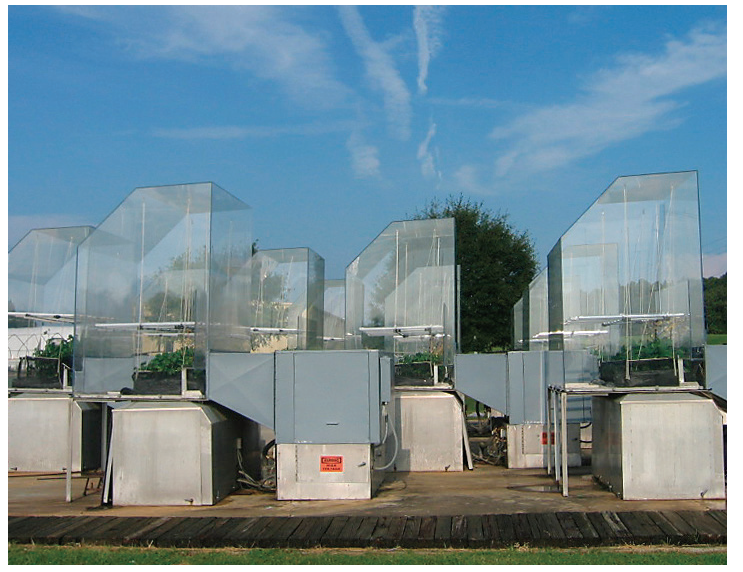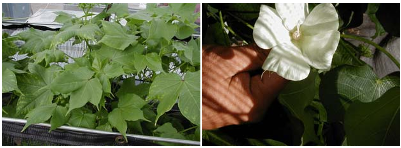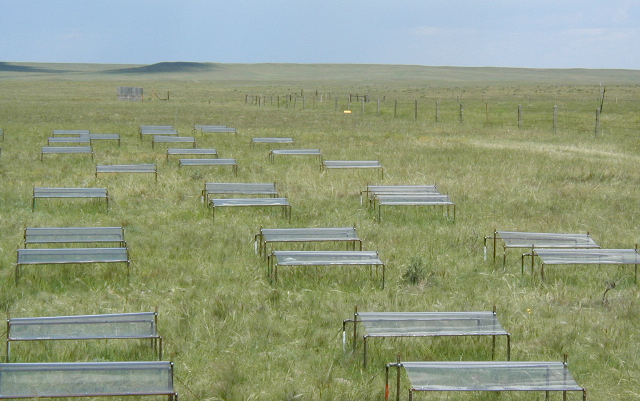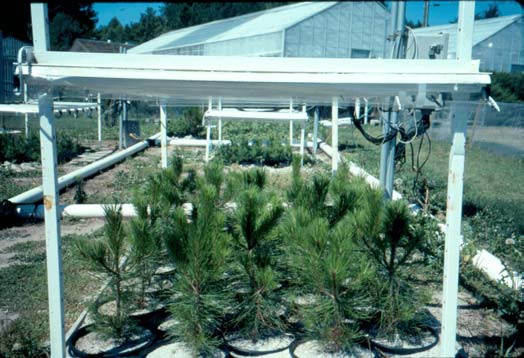UV-B radiation affects agriculture and ecosystems in complex interactions with environmental change. Increasing UV-B radiation is known to harm crops, causing damage in 66% of plant cultivars tested. It can harm crops directly, through heritable mutations in DNA, changes to membranes, protein denaturation, and indirectly through changes to many physiological and growth processes. As part of its overall mandate, UVMRP has supported effects studies designed to establish levels of UV-B radiation that are harmful to agricultural and economically important crops. We have been conducting experiments to evaluate the isolated and combined effects of UV-B radiation and other environmental stressors on crops by working with a research group of Dr. Raja Reddy at Mississippi State University (MSU). By using the Soil-Plant-Atmosphere-Research (SPAR) facility (computerized environmental chambers to control the enclosed environments over a wide range of set environmental stressors such as atmospheric CO2 concentrations, humidity, UV-B radiation, soil water and nutrients, and other parameters) we examine effects of these environmental stressors on the growth and development of specific crops (e.g., cotton, corn, soybean, wheat, and rice). Earlier studies of sorghum, barley, cucumber, spinach, and lettuce were conducted in greenhouses and in open-air research fields. Prior research also examined effects on trees (both deciduous and coniferous), wine grapes, forage used by rabbits, rangeland plants, nematodes, soil arthropods, and the decomposition of leaf litter. The results of these studies were/are incorporated into models of crops, trees, and rangelands for further studies.

The Soil-Plant-Atmosphere-Research (SPAR) facility at Mississippi State University, ten naturally-lit, controlled environment chambers are uniquely useful for studying plant/crop responses to combinations of variables (environmental stressors) in controlled field-like environments. These capacities allow simultaneous determination of several plant/crop responses (e.g., canopy photosynthesis, respiration, transpiration, tissue temperatures, growth, and development of organs) to precisely controlled conditions (e.g., temperatures from 5 to 45°C, CO2 concentrations from 150 to 1,000 ppm, UV-B radiation from 0 levels to several times ambient levels) and the ability to manipulate a wide range of water and nutrients through a set of sensors and program algorithms. The gas-exchange processes and many soils and aerial environmental conditions are measured and/or adjusted on a 10-second basis in each SPAR unit.

Studies at MSU demonstrate that cotton plants grown under enhanced UV-B radiation do not flower (far left), but grown at optimum temperature and zero UV-B radiation is normal in appearance. These studies on cotton aim to understand the interactive effects of UV-B radiation and environmental stressors on cotton growth, development, and yield. Using the SPAR facility at MSU, the objectives of these studies were to test the hypothesis that elevated UV-B radiation will modify transpiration, respiration, carbon acquisition, development, reproduction, and yield, and to understand the physiological, anatomical, and phenological basis of these effects. The algorithms describing the effects of UV-B radiation on cotton were incorporated to a dynamic cotton (Gossympium hirsutum L.) crop simulation model, GOSSYM, and tested for impact analysis in the fourteen Southern US states.
Publications
Liang, X., M. Xu, W. Gao, K. R. Reddy, K. Kunkel, D. L. Schmoldt, and A. N. Samel. 2012. A Distributed Cotton Growth Model Developed from GOSSYM and Its Parameter Determination. Agronomy Journal, 104(3), 661-674. doi: 10.2134/agronj2011.0250
Liang, X., M. Xu, W. Gao, K. R. Reddy, K. Kunkel, D. L. Schmoldt, and A. N. Samel. 2012. Physical Modeling of U.S. Cotton Yields and Climate Stresses during 1979 to 2005. Agronomy Journal, 104(3), 675-683. doi: 10.2134/agronj2011.0251
Wang, X., W. Gao, J. R. Slusser, J. Davis, B. Olson, S. Janssen, G. Janson, B. Durham, R. Tree, and R. Deike. 2006. USDA UV-B monitoring system: An application of centralized architecture. Computers and Electronics in Agriculture, 64(2), 326-332. doi: 10.1016/j.compag.2008.04.006
Zhao, D., K. R. Reddy, V. G. Kakani, S. Koti, and W. Gao. 2005. Physiological causes of cotton fruit abscission under conditions of high temperature and enhanced ultraviolet-B radiation. Physiologia Plantarum, 124(2), 189-199. doi: 10.1111/j.1399-3054.2005.00491.x
Reddy, K. R., S. Koti, V. G. Kakani, D. Zhao, and W. Gao. 2005. Genotypic variation of soybean and cotton crops in their response to UV-B radiation for vegetative growth and physiology. Proceedings of SPIE, Ultraviolet Ground- and Space-based Measurements, Models, and Effects V, 5886, 58860K. doi: 10.1117/12.619899
Kakani, V. G., K. R. Reddy, D. Zhao, and W. Gao. 2004. Senescence and hyperspectral reflectance of cotton leaves exposed to ultraviolet-B radiation and carbon dioxide. Physologia Plantarum, 121(2), 250-257. doi: 10.1111/j.1399-3054.2004.00314.x
Reddy, K. R., V. G. Kakani, D. Zhao, S. Koti, and W. Gao. 2004. Interactive Effects of Ultraviolet-B Radiation and Temperature on Cotton Physiology, Growth, Development and Hyperspectral Reflectance. Photochemistry and Photobiology, 79(5), 416-427. doi: 10.1111/j.1751-1097.2004.tb00029.x
Zhao, D., K. R. Reddy, V. G. Kakani, A. R. Mohammed, J. J. Read, and W. Gao. 2004. Leaf and canopy photosynthetic characteristics of cotton (Gossypium hirsutum) under elevated CO2 concentration and UV-B radiation. Journal of Plant Physiology, 161(5), 581-590. doi: 10.1078/0176-1617-01229
Kakani, V. G., K. R. Reddy, D. Zhao, and W. Gao. 2004. Leaf senescence and hyperspectral reflectance of cotton leaves exposed to ultraviolet-B radiation and carbon dioxide. Physologia Plantarum, 121(2), 250-257.
Gao, W., Y. Zheng, J. R. Slusser and G. M. Heisler. 2003. Impact of enhanced Ultraviolet-B irradiance on cotton growth, development, yield, and qualities under field conditions. Agricultural and Forest Meteorology, 120(1-4), 241-248.
Reddy, K. R., V. G. Kakani, D. Zhao, A. R. Mohammed, and W. Gao. 2003. Cotton responses to Ultraviolet-B radiation: experimentation and algorithm development. Agricultural and Forest Meteorology, 120, 249-266.

The studies at Cornell University were focused on the effects of UV-B radiation on grapevine powdery mildew. The studies showed that ambient levels of UV-B radiation inhibit mildew germination and establishment, and prevent the development of mildew colonies. The studies demonstrated that the grape growers can limit the mildew by increasing sunlight intercepted by leaves and fruits.
Publications
Austin, C. N., and Wilcox, W. F. 2012. Effects of sunlight exposure on grapevine powdery mildew development. Phytopathology 102:857-866. Austin, C.N., Meyers, J., Grove, G.G., and Wilcox, W.F. 2011. Quantification of powdery mildew severity as a function of canopy variability and associated impacts on sunlight penetration and spray coverage within the fruit zone. Amer. J. Enol. Vitic. 62 (1):23-31.
The rangeland studies examined the influence of UV-B radiation on plant production, litter decomposition, and soil carbon storage in the shortgrass steppe, important rangeland of the western US. The studies found that some plant species grew more when UV-B radiation was blocked but only in dry years, while other species did so only in wet years. Some species also produced foliage of better quality for grazing with ambient levels of UV-B radiation, but this depended on precipitation.
Publications
Milchunas, D. G., J. Y. King, A. R. Mosier, J. C. Moore, J. A. Morgan, M. H. Quirk, and J. R. Slusser. 2004. UV radiation effects on plant growth and forage in shortgrass steppe ecosystems. Photochemistry and Photobiology, 79(5), 404-410. doi: 10.1111/j.1751-1097.2004.tb00027.x
King, J. Y., D. G. Milchunas, A. R. Mosier, J. C. Moore, M. H. Quirk, J. A. Morgan, and J. R. Slusser. 2003. Initial impacts of altered UVB radiation on plant growth and decomposition in shortgrass steppe. Proceedings of SPIE, Ultraviolet Ground- and Space-based Measurements, Models, and Effects III, 5156, 384-395. doi: 10.1117/12.508606
The studies on canopy aimed to simulate the amount of UV-B radiation within and under a vegetation canopy. The studies resulted in a 3-D UV Radiation Transfer model, which calculates the amount of UV-B radiation passing through a canopy at any location below a canopy. Given sky conditions and canopy composition and structure, this model can predict UV-B radiation levels below canopies of agricultural crops, orchards, and trees in urban areas.
Publications
Gao, W., R. H. Grant, G. M. Heisler and J. R.Slusser. 2003. Ultraviolet-B radiation in a row-crop canopy: An extended 1-D model. Agricultural and Forest Meteorology, 120(1-4), 141-151.
Heisler, G. M., R. H. Grant, D. J. Nowak, W. Gao, D. E. Crane, and J. T. Walton. 2003. Inclusion of an Ultraviolet Radiation transfer component in an urban forest effects model for prediction tree influences in potential below- canopy exposure to UVB radiation. Proceedings of SPIE, Ultraviolet Ground- and Space-based Measurements, Models, and Effects III, 5156, 228-235. doi: 10.1117/12.509193
Gao, W., R. H. Grant, G. M. Heisler, and J. R. Slusser. 2001. Modeling ultraviolet-B radiation in a maize canopy. Proceedings of SPIE, Ultraviolet Ground- and Space-based Measurements, Models, and Effects, 4482, 395-407. doi: 10.1117/12.452943

The studies on trees examined how tree leaves absorb, reflect, and pass UV-B radiation. With collaborators from Southern University, the USDA Forest Service Northeastern Research Station, and the University of Vermont, the studies examined how tree leaves tolerate UV-B radiation, for more than 30 common broadleaf tree species in the southern US. The studies established a database of leaf optical properties, depth of UV-B penetration into leaves, the concentration of UV-B absorbing compounds, and leaf anatomy. The studies showed that on a whole leaf basis, the tree leaves absorb 91% −95%, reflect 5% − 9%, and transmit less than 1% incident UV-B radiation. They also showed that leaf chlorophyll content predicted the green light reflectance, transmittance, and absorbance and that UV-B reflectance was predicted by leaf thickness and leaf UV-B absorbing compound concentrations.
Publications
Thines, N. J., L. A. Shipley, J. H. Bassman, J. K. Fellman, D. S. Mattison, J. R. Slusser, and W. Gao. 2007. Effects of Enhanced UV-B Radiation on Plant Chemistry: Nutritional Consequences for a Specialist and Generalist Lagomorph. Journal of Chemical Ecology, 33(5), 1025-1039. doi: 10.1007/s10886-007-9280-7
Yadong Qi, Shuju Bai, Gordon M. Heisler. 2003. Changes in ultraviolet-B and visible optical properties and absorbing pigment concentrations in pecan leaves during a growing season. Agriculture and Forest Meteorology 12/2003. doi: 10.1016/j.agrformet.2003.08.018

